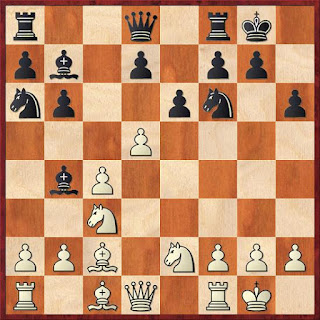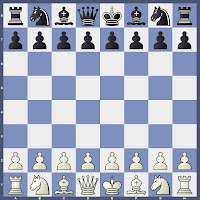"Leveraging" a lever!: h6....h3....a3 - A perspective from C Aravindh vs SL Narayanan's game
"In Chess, human intelligence achieves a creativity which cannot be explained away in terms of conditioned reflexes or the formation of habits. Mental habits and memory are elements in the Chess mind as a knowledge of his language is part of the equipment of an orator, or as a technique is essential to the musician.
Beyond that equipment training ends, and the mind creates from its own resources and material. What a good chess player does is comparable, as a mental act, to what the inventor does, be he a scientist or a poet; an act of free imagination, which changes its own surroundings by the revelation of latent possibilities." - Gerald Abrahams
The language used for the title in itself is quite controversial.....the usage of "leveraging"....using the term Lever as a verb!
Yet.....everything else in this world, the language should also be 'malleable' .....accommodative.....after all a language is a mere tool to communicate .....and it is the poorest form of communication at highest level!
As long as it evokes an image....the intended one....in the minds of the receiver, it has served its purpose!
The rising star of Indian Chess, Aravind Chidambaram played a nice game yesterday in the ongoing National Premier Championship, against SL Narayanan - another up and coming Grandmaster.
Aravindh Chidambaram - S.L. Narayanan,
Ind Premier Ch, 2017
Let us take this position...
12.....Qd6
Nothing special about this move.....and is absolutely normal. Normal and not special under the context of normal perception ......and let me reiterate - as William Cluley expressed in 19th century...a game of Chess is fundamentally a game of equilibrium! When two players of equal strength play in a principled way.....the game should drift invariably towards equality.
Napoleon Bonaparte won battles after battles, which he was supposed to lose (as there is no draw in war!) as per conventional wisdom, because he followed his instincts instead of rational tactics taught in military schools. He assumed battlefield as Chessboard and went on to take outlandish and unexpected decisions .....and he was considered a mystical leader who could not lose!
13.Qe2 h6
I have the proclivity to condemn the push of h-pawn in particular and the Rook pawns in general.....without a strong reason....for two reasons:
a) It unnecessary weakens the pawn chain and acts as a lever luring opponent attention
b) At times, it takes away that square which his major pieces might need if and when an attack upon the opponent King is conceived.
It is a move which came into master praxis only to prevent any imminent threats and far into an attack.....as a waiting move which gives a loophole for the King safeguarding against the back-rank threats.
White's 12.h3 was in line with his plan of action.....his Rook had moved to e-file weakening the f2 square and the Bishop on c1 is yet to be born and Black was threatening Ng4 with his 11......Bc5
14.Nc4! Qe7 15.Ne3 Na5?!
Mistakes in Chess does not happen singly. And Chess is a highly resilient game which would tolerate few mistakes from a side.....and still provides one with leeway to escape unscathed.
Often, we see that such a Knight move proving counterproductive......even the great Tarrasch who said that that Knight on the rim is dim....was not immune to that and had succumbed to that very sin!
Why not keep him in the centre....and perhaps put him on d4!? No harm done!
16.Ba2 Be6?!
This doesn't certainly go well with the previous move. Black requires that light squared Bishop to control the f5 square. He may even play 16.....Be3, certainly that Knight looks more menacing and useful than that Bishop on c5.
17.Be6 Qe6 18.Nf5 Rfd8 19.Bh6!!
A couple of pawns and few tempos are more than sufficient for this....over the board.....I am not even counting the estranged Knight on a5! ........and
........I am damn cared what the postmortem and the devil called "engine" will think about this move.
This move is precisely what explains the assertion by Gerald Abrahams (quoted in the beginning):
"...... an act of free imagination, which changes its own surroundings by the revelation of latent possibilities."
My interest in this position ends here, for the subject under purview.....Aravind won the game in a fine fashion .....and ofcourse every win requires the help of one's opponent!
Well, h6....in general, is a great lever.....trigger. One of the finest example of it is this game
Bronstein - Keres, Gothenburg Intz, 1955
If Einstein is to Science; Leonardo is to Art then........ Bronstein is for Chess! One of the finest creator.....incorrigible optimist.....great improviser!
In this position, Bronstein played....
11.Nb5!!
The idea of this move rests on the other side of the board! Bronstein is aiming at the 'h6' lever.....and is in dire need of the f5 square!
And a pawn is the least that he could part with.....to lure great Keres!
Of course, the move also threatens a3! by the way!
11......ed5
Keres falls into Bronstein plan!
12.a3! Be7 13.Ng3! dc4 14.Bh6!!
Aravind Chidambaram can be proud that his Bishop sortie was a la Bronstein's
Bronstein won the game without much ado.....after this!
Well, do you require a pawn lever on h6 at all....!? Do you require that 'f5' square unmarked at all....!?
Jobava Baadur answers in negative!
Jobava - Ponomariov, Baku Oly, 2016
This is why Black left that e7 Bishop undefended......he was hoping to gobble the Rook alive!
17.Bh6!!
A move akin to Coleridge's poem purportedly written in an inebriated state! And such moves and play has the power to take the onlooker too to inebriated state!!
It is not easy to spot this move.....Bh6 or Bh3 or Ba3 etc....when the pawn is not on that square! Perhaps that is why Ponomariov missed it too!
And great Gary missed it too.....
Judit Polgar - Gary Kasparov, Linares - 2001
27.....Ba3!!
....here...which wins in all lines....although complex .... and instead played 27.....g6? and the game ended in a perpetual check.
The precursor to this theme, ofcourse, is the well known masterpiece by Lasker!
Lasker - Bauer, Amsterdam, 1889
Though the setting and method is different, in spirit it is the same - disrupting the King cover!
14.Nh5!
To remove the supporter of the Kingside pawn
14......Nh5 15.Bh7!! Kh7 16.Qh5 Kh8 17.Bg7!!
Kasparov quipped that Lasker might have tried to copyright this idea.....!
Iteration is imperative in Chess.....but the scene and settings differ.....and hence such moves are original and not copies....
.....and such levers are perceived by the human mind......individually....like an inventor.... dictated by the needs of the position, intensity of the fight, opponent and his responses thus far.....and other factors! All that Caissa demands is freedom of thought and expression.....unrestrained......
Let me reiterate....
"In Chess, human intelligence achieves a creativity which cannot be explained away in terms of conditioned reflexes or the formation of habits. Mental habits and memory are elements in the Chess mind as a knowledge of his language is part of the equipment of an orator, or as a technique is essential to the musician. Beyond that equipment training ends, and the mind creates from its own resources and material"
I remain







.jpg)
.jpg)

Comments
Post a Comment